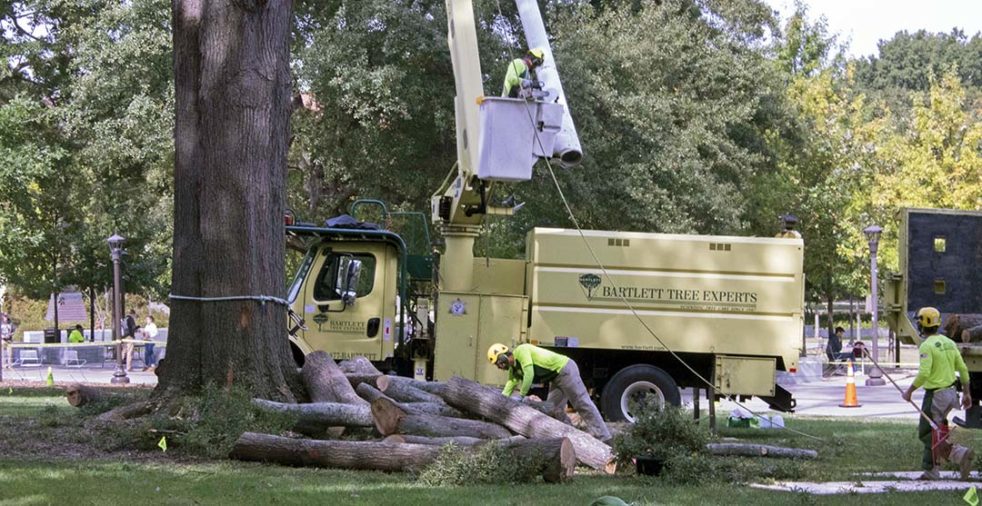Tables covered by snacks such as pecan pie, acorn jelly and birch tree juice enticed dozens of hungry students to step away from the stress of their projects, assignments and deadlines and to investigate the “Fall of a Champion” exhibit on the third floor of the Clough Commons. Hosted by the fall 2018 class of LMC 3308 Environmentalism and Ecocriticism, the event memorialized the Skiles Walkway willow oak that collapsed on September 18, 2018, an oak the class affectionately calls “Big Al.”
“We were in the LMC course [Environmentalism and Ecocriticism],” Alex Flack, a third-year International Affairs major explained, “and halfway through the semester, the big oak fell down. We wanted to preserve the history and legacy of the champion tree.”
In order to honor this champion tree, the class created a multitude of different artifacts. Examples included a book they wrote about the tree life on campus, woodworking projects they built themselves from the remnants of Big Al and a video showcasing their construction process. Those who had been lured by the scent of snacks quickly discovered that even the paperware and utensils in which they were eating from were made from the fallen oak.
Professor Hugh Crawford explained why he integrated woodworking into his LMC 3308 Environmentalism and Ecocriticism course, describing it as an effort to cultivate cognitive engagement and add some creativity to students’ learning.
“I was working on hands-on learning and questions about cognition and tool use. So that’s what started the woodworking,” Crawford explained. “And because I am a literature professor, the cultural history of trees is just fascinating.”
Crawford’s students shared his enthusiasm for tool use, as evidenced by the excited manner in which they shared stories from their workshop sessions.
“I had no experience [in woodworking], but I got to use a two-person saw, which was a real blast,” Flack recalled.
Students not only beamed when discussing their woodworking, but they also fondly recalled another assignment of theirs which required them to sit underneath a tree for thirty minutes a week with no technology. Kathryn Higinbotham, second-year LMC, explained how this simple exercise taught her the importance of stillness.
“It really shifts your perspective on time and what you should be doing with it. Because we have a sense, especially at Tech, that everything is about efficiency, and going and being productive,” Higinbotham said.
“So the first couple of times that I sat under the tree, I was constantly thinking about my homework and what had to get done, but it slowly changed over time to where I genuinely started to look forward to it. It became this moment of peace and time to be contemplative.”
Despite the class having ended last semester, Higinbotham can still be found sitting among the trees of campus. Classes such as the one taught by Crawford stretch the narrow definition that both faculty and students often place on learning. Despite the value behind alternative approaches to learning, most students never encounter assignments as engaging as crafting woodworks or as introspective as sitting outdoors. Instead, most students spend the majority of their time hunched over their computers, praying to have their homework turned in before Canvas locks them out at that detested midnight deadline.
As evidenced by the “Fall of a Champion” exhibit, the opportunity to learn can come from outside the classroom, and even from unlikely sources. From working with and sitting with trees, students gained skills and insights that could not have come from the traditional classroom setting. Their intellectual and personal growth reveals that learning is not just confined to the buildings of academic institutions: it doesn’t stop when the steam whistle is blown or the book is closed. Nor is it rigidly defined by the grades you make or the number of credit hours you take. Just as the limbs of a tree extend far beyond its trunk, opportunities to learn extend far beyond the classroom. With over 12,000 trees on campus, how many do you pass a day, and how many do you notice? How many opportunities to learn and grow come your way, and how many do you seize?
